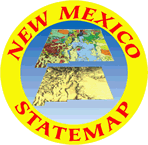
Water Resources
Jump to
Like many other states in the west, New Mexico is arid. Water is a precious natural resource that is becoming increasingly scarce as demand for the resource increases. Although political and legal considerations weigh heavily on how water is used, impartial science plays an important role in informing decision-makers on water resource issues. As New Mexico is facing more extreme water challenges, as summarized in the 2023 New Mexico Water and Climate Report, we need robust science and data to help us plan our water future. At the Bureau of Geology, many of our basic research projects deal directly or indirectly with the need to understand the geologic context and hydrologic dynamics of our state’s aquifers.
See our story map "Groundwater in New Mexico: Our precious shared resource" for an overview of our groundwater resources and the varied types of aquifers in our state (other story maps are also available).
Hydrogeology Programs
Associate Director, Stacy Timmons
The hydrogeology programs at the New Mexico Bureau of Geology and Mineral Resources have been slowly growing since the 1990s, when we began with geologic mapping and collaborative hydrologic research in the Albuquerque Basin. Currently, there are three water-focused programs at the Bureau, including the Aquifer Mapping Program, the Water Data Program, and the Water Education Program for water decision-makers.
Our Aquifer Mapping Program conducts hydrogeologic research for the state of New Mexico. Hydrogeology is the science of hydrology and geology as it relates to the movement of groundwater and its distribution within the Earth’s aquifers. Since the early 1990s, our staff have been engaged in hydrogeologic studies of New Mexico’s aquifers in cooperation with other federal, state, and local agencies. The Aquifer Mapping Program applies a combination of geologic, geophysical, hydrologic, and geochemical information to develop descriptive models of groundwater flow in important aquifers around the state (more information about the program).
After passage of the 2019 Water Data Act, collaborative work towards modernizing how New Mexico manages, shares and accesses water data began, as convened by the New Mexico Bureau of Geology and Mineral Resources. In collaboration with numerous federal, local, and state agencies and organizations, a collective effort known as the Water Data Initiative, began cataloging water data sources, providing data standards, and building improved access to data using modern applications and services. More information can be found at: https://newmexicowaterdata.org/
After the completion of many successful Decision Makers Field Conferences, organized by the Bureau in the early 2000s, a new water-focused education program for decision makers was launched. Piloted in 2022 with funding from Thornburg Foundation, a successful new format water conference was held over 2 days including classroom and field trip excursions to view and discuss some of New Mexico’s most challenging water issues. Water Leaders Workshops were funded from a state appropriation in 2023, marking the beginning of a new era of water education for water leaders and decision makers. More information can be found here: https://newmexicowatereducation.org/
Related Programs
These programs at the New Mexico Bureau of Geology and Mineral Resources either support or are closely related to the hydrogeology programs above.
Chemistry Laboratory — Inorganic Water Analyses
Our Chemistry Laboratory is a service and research facility. Its primary purpose is to provide inorganic water analyses support for Bureau of Geology projects but additionally provides analyses the New Mexico Tech community and to individuals and entities outside the New Mexico Tech community. It is equipped to perform inorganic analyses of environmental, geochemical and geologic materials.
Geothermal Resources —Thermal Waters
The geothermal resources of New Mexico are used for recreation, commercial spas, greenhouses, fish hatcheries, indoor space heating, and localized power generation. Deep groundwater circulation in the vicinity of the Rio Grande rift, an area characterized by high regional heat flow, is the source heat for many thermal springs and wells. A few thermal springs in the Jemez Mountains of north-central New Mexico are warmed by residual heat associated with a cooling magma chamber that is less than 50,000 years old.
Geologic Mapping — STATEMAP Program

Modern geologic maps are essential for New Mexico's environmental and economic prosperity. Geologic maps are uniquely suited to solving problems involving Earth resources, hazards, and environments, and perhaps most importantly for the people of New Mexico, such maps help identify and protect ground-water aquifers, aid in locating water-supply wells, and are fundamental for all environmental studies and land-use plans. Our STATEMAP Program is jointly funded by the USGS and the Bureau of Geology as part of our mission.






